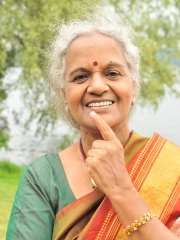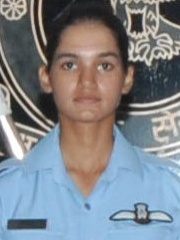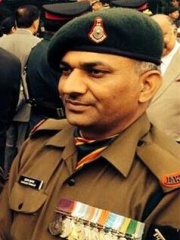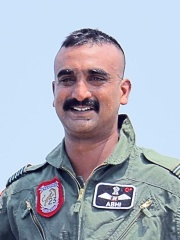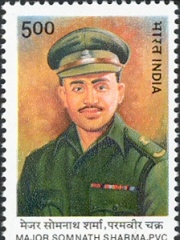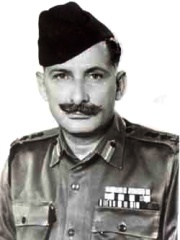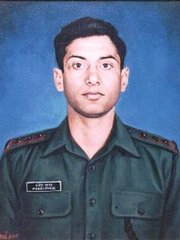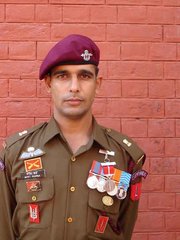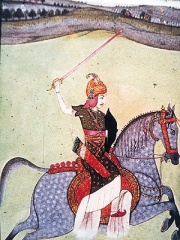
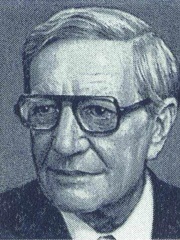
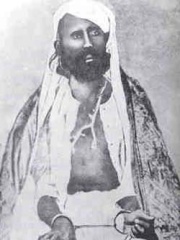
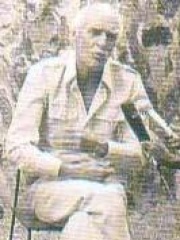
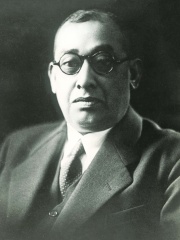
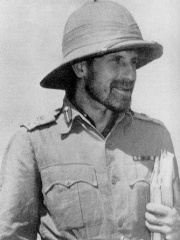
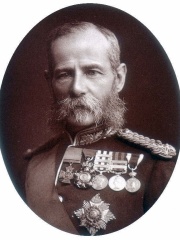
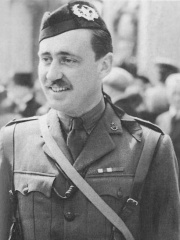
The Most Famous
MILITARY PERSONNELS from India
This page contains a list of the greatest Indian Military Personnels. The pantheon dataset contains 2,058 Military Personnels, 22 of which were born in India. This makes India the birth place of the 15th most number of Military Personnels behind Spain, and Austria.
Top 10
The following people are considered by Pantheon to be the top 10 most legendary Indian Military Personnels of all time. This list of famous Indian Military Personnels is sorted by HPI (Historical Popularity Index), a metric that aggregates information on a biography's online popularity. Visit the rankings page to view the entire list of Indian Military Personnels.

1. Baji Rao I (1700 - 1740)
With an HPI of 69.90, Baji Rao I is the most famous Indian Military Personnel. His biography has been translated into 37 different languages on wikipedia.
Bajirao I (born Visaji, Marathi: [ˈbaːdʑiɾaːʋ bəˈlːaːɭ̆]; 18 August 1700 – 28 April 1740) was the 7th Peshwa of the Maratha Empire. In the Deccan region, the Nizam of Hyderabad emerged as a significant threat. Bajirao then led a campaign against the Nizam in which Nizam suffered a decisive defeat at Palkheda. This victory solidified the Marathas’ authority in the Deccan region. In Bundelkhand, he rescued the Bundela ruler Chhatrasal from a Mughal siege, gaining independence for Bundelkhand. Gratefully, Chhatrasal granted Bajirao a jagir and his daughter's hand in marriage. In the 1730s, Bajirao asserted Maratha tax rights in Gujarat, defeating rebel Trimbak Rao Dabhade in 1731 at Battle of Dabhoi; he also engaged in a diplomatic mission to persuade Rajput courts for chauth payments. Further efforts to establish Maratha dominance saw him responsible for the Battle of Delhi (1737) which may be said to mark the pinnacle of his military career. He secured the important territory of Malwa after defeating the combined forces of Mughal-Nizam-Nawab of Awadh in Battle of Bhopal (1737). Bajirao's adventurous life has been picturized in Indian cinema and also featured in novels. Bajirao had two wives Kashibai and Mastani. Bajirao's relationship with his second wife Mastani is a controversial subject; very little is known with certainty about it. She was generally referenced cryptically in books, letters or documents from that era.

2. Kim Philby (1912 - 1988)
With an HPI of 69.30, Kim Philby is the 2nd most famous Indian Military Personnel. His biography has been translated into 43 different languages.
Harold Adrian Russell "Kim" Philby (1 January 1912 – 11 May 1988) was a British intelligence officer and a double agent for the Soviet Union. In 1963, he was revealed to be a member of the Cambridge Five, a spy ring that had divulged British secrets to the Soviets during World War II and in the early stages of the Cold War. Of the five, Philby is believed to have been the most successful in providing secret information to the Soviets. Born in British India, Philby was educated at Westminster School and Trinity College, Cambridge. He was recruited by Soviet intelligence in 1934. After leaving Cambridge, Philby worked as a journalist, covering the Spanish Civil War and the Battle of France. In 1940, he began working for the United Kingdom's Secret Intelligence Service (SIS or MI6). By the end of the Second World War he had become a high-ranking member. In 1949, Philby was appointed first secretary to the British Embassy in Washington and served as chief British liaison with American intelligence agencies. During his career as an intelligence officer, he passed large amounts of intelligence to the Soviet Union, including the Albanian Subversion, a scheme to overthrow the pro-Soviet government of Communist Albania. Philby was suspected of tipping off two other spies under suspicion of Soviet espionage, Donald Maclean and Guy Burgess, both of whom subsequently fled to Moscow in May 1951. Under suspicion himself, Philby resigned from MI6 in July 1951 but was publicly exonerated by then-Foreign Secretary Harold Macmillan in 1955. He resumed his career as both a journalist and a spy for MI6 in Beirut, but was forced to defect to Moscow after finally being unmasked as a Soviet agent in 1963. Philby lived in Moscow until his death in 1988.

3. Tatya Tope (1814 - 1859)
With an HPI of 64.63, Tatya Tope is the 3rd most famous Indian Military Personnel. His biography has been translated into 25 different languages.
Tantia Tope (also spelled Tatya Tope, Marathi pronunciation: [t̪aːt̪ʲa ʈoːpe]; 16 February 1814 — 18 April 1859) was an Indian general in the Indian Rebellion of 1857 against the British East India Company.

4. Mad Mike Hoare (1919 - 2020)
With an HPI of 62.86, Mad Mike Hoare is the 4th most famous Indian Military Personnel. His biography has been translated into 20 different languages.
Thomas Michael "Mad Mike" Hoare (17 March 1919 – 2 February 2020) was a British-Irish military officer and mercenary who fought during the Simba rebellion and was involved in carrying out the 1981 Seychelles coup d'état attempt.
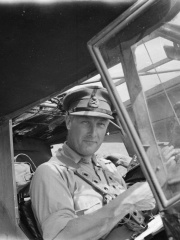
5. Kenneth Anderson (1891 - 1959)
With an HPI of 61.26, Kenneth Anderson is the 5th most famous Indian Military Personnel. His biography has been translated into 18 different languages.
General Sir Kenneth Arthur Noel Anderson, (25 December 1891 – 29 April 1959) was a senior British Army officer who saw service in both world wars. He is mainly remembered as the commander of the British First Army during Operation Torch, the Allied invasion of North Africa and the subsequent Tunisian campaign which ended with the capture of almost 250,000 Axis soldiers. An outwardly reserved character, he did not court popularity either with his superiors or with the public. His American superior, General Dwight D. Eisenhower, wrote that he was "blunt, at times to the point of rudeness". In consequence he is less well known than many of his contemporaries. According to Richard Mead, however, "he handled a difficult campaign more competently than his critics suggest, but competence without flair was not good enough for a top commander in 1944."

6. Rash Behari Bose (1886 - 1945)
With an HPI of 60.72, Rash Behari Bose is the 6th most famous Indian Military Personnel. His biography has been translated into 18 different languages.
Rashbehari Bose ( ; 25 May 1886 – 21 January 1945) was an Indian revolutionary leader and freedom fighter who fought against the British Empire. He was one of the key organisers of the Ghadar Mutiny and founded the Indian Independence League. Bose also led the Indian National Army (INA) which was formed in 1942 under Mohan Singh. He was behind the Delhi-Lahore Conspiracy to assassinate the Viceroy of India, Lord Hardinge, in 1912. After the failed assassination attempt, Bose fled to Imperial Japan. He sided with Azad Hind against Britain in World War II.

7. Orde Wingate (1903 - 1944)
With an HPI of 59.16, Orde Wingate is the 7th most famous Indian Military Personnel. His biography has been translated into 23 different languages.
Major-General Orde Charles Wingate, (26 February 1903 – 24 March 1944) was a senior British Army officer known for his creation of the Chindit deep-penetration missions in Japanese-held territory during the Burma Campaign of the Second World War. Wingate was an exponent of unconventional military thinking and the value of surprise tactics. Wingate was a dedicated Christian Zionist. In Mandatory Palestine, he set up a joint British–Jewish counter-insurgency unit called the Special Night Squads. Under the patronage of the area commander Archibald Wavell, Wingate was given increasing latitude to put his ideas into practice during the Second World War. He created units in Abyssinia and Burma. At a time when Britain was in need of morale-boosting generalship, Wingate attracted British Prime Minister Winston Churchill's attention with a self-reliant aggressive philosophy of war, and was given resources to stage a large-scale operation. The last Chindit campaign may have determined the outcome of the Battle of Kohima, although the offensive into India by the Japanese may have occurred because Wingate's first operation had demonstrated the possibility of moving through the jungle. In practice, both Japanese and British forces suffered severe supply problems and malnutrition. Wingate was killed in an aircraft accident in March 1944. The casualty rate the Chindits suffered, especially from disease, is a continuing controversy. Wingate believed that resistance to infection could be improved by inculcating a tough mental attitude, but medical officers considered his methods unsuited to a tropical environment.

8. Frederick Roberts, 1st Earl Roberts (1832 - 1914)
With an HPI of 58.74, Frederick Roberts, 1st Earl Roberts is the 8th most famous Indian Military Personnel. His biography has been translated into 25 different languages.
Field Marshal Frederick Sleigh Roberts, 1st Earl Roberts (30 September 1832 – 14 November 1914), was a British Victorian era general who became one of the most successful British military commanders of his time. Born in India to an Anglo-Irish family, Roberts joined the East India Company Army and served as a young officer in the Indian Rebellion during which he was awarded the Victoria Cross for gallantry. He was then transferred to the British Army and fought in the Expedition to Abyssinia and the Second Anglo-Afghan War, in which his exploits earned him widespread fame. Roberts would go on to serve as the Commander-in-Chief, India, before leading British forces for a year during the Second Boer War. He also became the last Commander-in-Chief of the Forces before the post was abolished in 1904. A man of small stature, Roberts was affectionately known to his troops and the wider British public as "Bobs" and revered as one of Britain's leading military figures at a time when the British Empire reached the height of its power. He became a symbol for the British Army and in later life became an influential proponent of stronger defence in response to the increasing threat that the German Empire posed to Britain in the lead-up to the First World War.

9. John Frost (1912 - 1993)
With an HPI of 58.57, John Frost is the 9th most famous Indian Military Personnel. His biography has been translated into 18 different languages.
Major-General John Dutton Frost, (31 December 1912 – 21 May 1993) was an airborne officer of the British Army, best known for being the leader of the small group of British airborne troops that actually arrived at Arnhem bridge during the Battle of Arnhem in Operation Market Garden, in the Second World War. He was one of the first to join the newly formed Parachute Regiment and served with distinction in many wartime airborne operations, such as in North Africa and Sicily and Italy, until his injury and subsequent capture at Arnhem. He retired from the army in 1968 to become a beef cattle farmer in West Sussex.
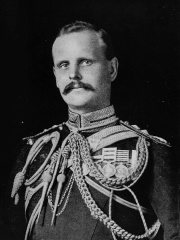
10. William Birdwood (1865 - 1951)
With an HPI of 57.52, William Birdwood is the 10th most famous Indian Military Personnel. His biography has been translated into 16 different languages.
Field Marshal William Riddell Birdwood, 1st Baron Birdwood (13 September 1865 – 17 May 1951) was a highly decorated and distinguished British Indian Army officer. He saw active service in the Second Boer War on the staff of Lord Kitchener. Birdwood saw action again in the First World War, initially as commander of the Australian and New Zealand Army Corps during the Gallipoli campaign in 1915, leading the landings on the peninsula and then the evacuation later in the year, before becoming commander-in-chief of the Fifth Army on the Western Front during the closing stages of the war. He then went on to be general officer commanding the Northern Army in India in 1920 and Commander-in-Chief, India, in 1925, and retired as a field marshal.
People
Pantheon has 27 people classified as Indian military personnels born between 1700 and 1994. Of these 27, 9 (33.33%) of them are still alive today. The most famous living Indian military personnels include Padma Bandopadhyay, Avani Chaturvedi, and Sanjay Kumar. The most famous deceased Indian military personnels include Baji Rao I, Kim Philby, and Tatya Tope. As of April 2024, 6 new Indian military personnels have been added to Pantheon including Manoj Kumar Pandey, Mohit Sharma, and Gunjan Saxena.
Living Indian Military Personnels
Go to all RankingsPadma Bandopadhyay
1944 - Present
HPI: 56.77
Avani Chaturvedi
1993 - Present
HPI: 39.04
Sanjay Kumar
1976 - Present
HPI: 36.21
Abhinandan Varthaman
1983 - Present
HPI: 35.66
Gunjan Saxena
HPI: 35.64
Bhawana Kanth
1992 - Present
HPI: 27.09
Mohana Singh Jitarwal
1992 - Present
HPI: 26.40
Priya Jhingan
HPI: 23.15
Noah Nirmal Tom
1994 - Present
HPI: 12.15
Deceased Indian Military Personnels
Go to all RankingsBaji Rao I
1700 - 1740
HPI: 69.90
Kim Philby
1912 - 1988
HPI: 69.30
Tatya Tope
1814 - 1859
HPI: 64.63
Mad Mike Hoare
1919 - 2020
HPI: 62.86
Kenneth Anderson
1891 - 1959
HPI: 61.26
Rash Behari Bose
1886 - 1945
HPI: 60.72
Orde Wingate
1903 - 1944
HPI: 59.16
Frederick Roberts, 1st Earl Roberts
1832 - 1914
HPI: 58.74
John Frost
1912 - 1993
HPI: 58.57
William Birdwood
1865 - 1951
HPI: 57.52
Somnath Sharma
1923 - 1947
HPI: 55.55
Sam Manekshaw
1914 - 2008
HPI: 55.33
Newly Added Indian Military Personnels (2025)
Go to all RankingsManoj Kumar Pandey
1975 - 1999
HPI: 38.63
Mohit Sharma
1978 - 2009
HPI: 36.09
Gunjan Saxena
HPI: 35.64
Bhawana Kanth
1992 - Present
HPI: 27.09
Mohana Singh Jitarwal
1992 - Present
HPI: 26.40
Priya Jhingan
HPI: 23.15
Overlapping Lives
Which Military Personnels were alive at the same time? This visualization shows the lifespans of the 13 most globally memorable Military Personnels since 1700.

